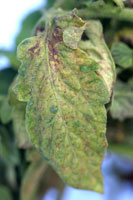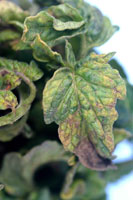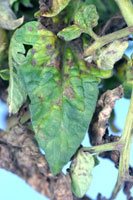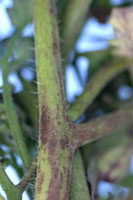 Click for larger image
Click for larger imageFig. A. Necrotic flecking and irregular chlorotic areas on tomato leaflet.
Received from:
Craig Webster
Scott Adkins
USDA-ARS-USHRL
Fort Pierce, FL 34945
(772)-462-5885
scott.adkins@ars.usda.gov
Keith L. Perry
Xiaoyun Lu
Cornell University
Department of Plant Pathology and Plant-Microbe Biology
Ithaca, NY 14853
Loren Horsman
Galen Frantz
Charles Mellinger
Glades Crop Care, Inc.
Jupiter, FL 33458
(561)-746-3740
cmellinger@gladescropcare.com
Symptoms resembling infection by a tospovirus were observed on tomato plants in the Homestead area from November 2009 through February 2010. Foliar symptoms included necrotic flecking/spots, irregular chlorotic areas and deformation of leaves (Figures A, B and C). Necrotic lesions on stem and petiole epidermal tissues were also observed (Figures C, D and E). Serological testing indicated the presence of a tospovirus in the majority of tomato samples from December and February. Groundnut ringspot virus (GRSV) was detected in one January and two February samples by specific molecular tests (RT-PCR and sequencing). To the best of our knowledge, this is the first report of GRSV in the U.S. although similar symptoms have been observed for about a decade on tomato plants in the Homestead area.
 Click for larger image
Click for larger image
Fig. A. Necrotic flecking and irregular chlorotic areas on tomato leaflet.
 Click for larger image
Click for larger image
Fig. B. Necrotic spots, irregular chlorotic areas and deformation (inward rolling) of tomato leaflets.
 Click for larger image
Click for larger image
Fig. C. Necrotic spots and irregular chlorotic areas on tomato leaflets, and necrotic lesions on tomato petioles.
 Click for larger image
Click for larger image
Fig. D. Necrotic lesions on tomato stem.
 Click for larger image
Click for larger image
Fig. E. Necrotic lesions on tomato petiole and deformation (inward rolling) of leaflets.
GRSV has previously been found in Argentina, Brazil and South Africa infecting hosts including tomato, pepper, peanut, soybean and coriander. Other hosts for GRSV in Florida are not currently known and need to be explored. The narrow host range of GRSV contrasts with the extremely wide host range of tomato spotted wilt virus, (TSWV), a tospovirus that is common in the southeastern U.S. and is closely related to GRSV. Both viruses induce similar symptoms on tomato necessitating serological or molecular tests to accurately identify which virus is present.
GRSV is transmitted exclusively by several species of thrips. The virus must be acquired by larval thrips for subsequent transmission as adults. Reported GRSV vectors include the western flower thrips (Frankliniella occidentalis), F. schultzei and F. gemina. Two of these species (F. occidentalis and F. schultzei) were observed in the Homestead tomato fields from which the December and February tomato samples were collected although it is not yet known which thrips species are able to transmit GRSV in Florida.
The close relationship of GRSV and TSWV likely indicates that integrated management strategies including the use of virus-free transplants and metalized (UV-reflective) mulch developed for TSWV by scientists at the University of Florida's North Florida Research and Education Center in Quincy will also be effective for GRSV. Additional information on TSWV management and tospoviruses in general can be found at http://nfrec.ifas.ufl.edu/programs/tomato_spotted_wilt_management.shtml and http://edis.ifas.ufl.edu/pp134 , respectively.